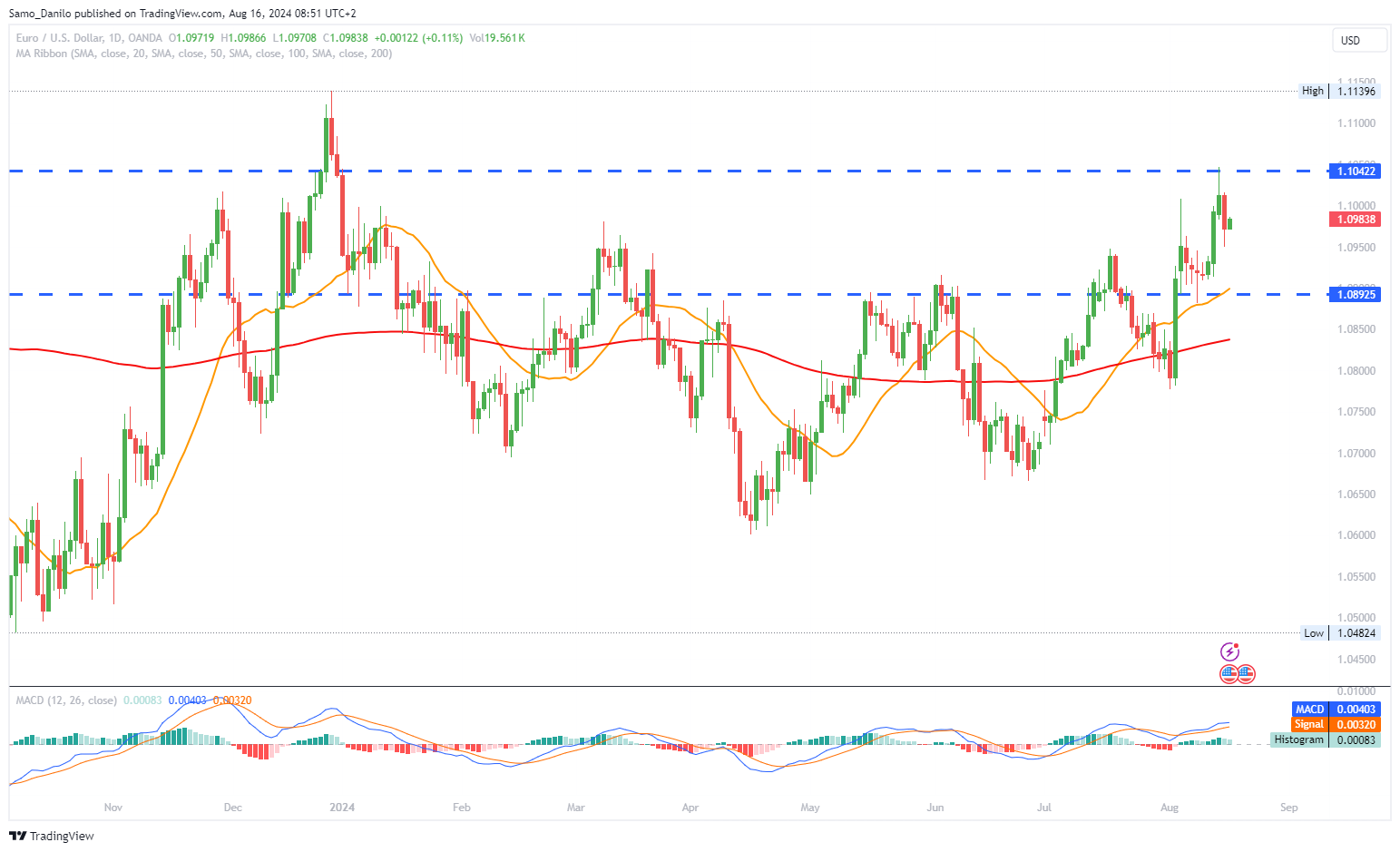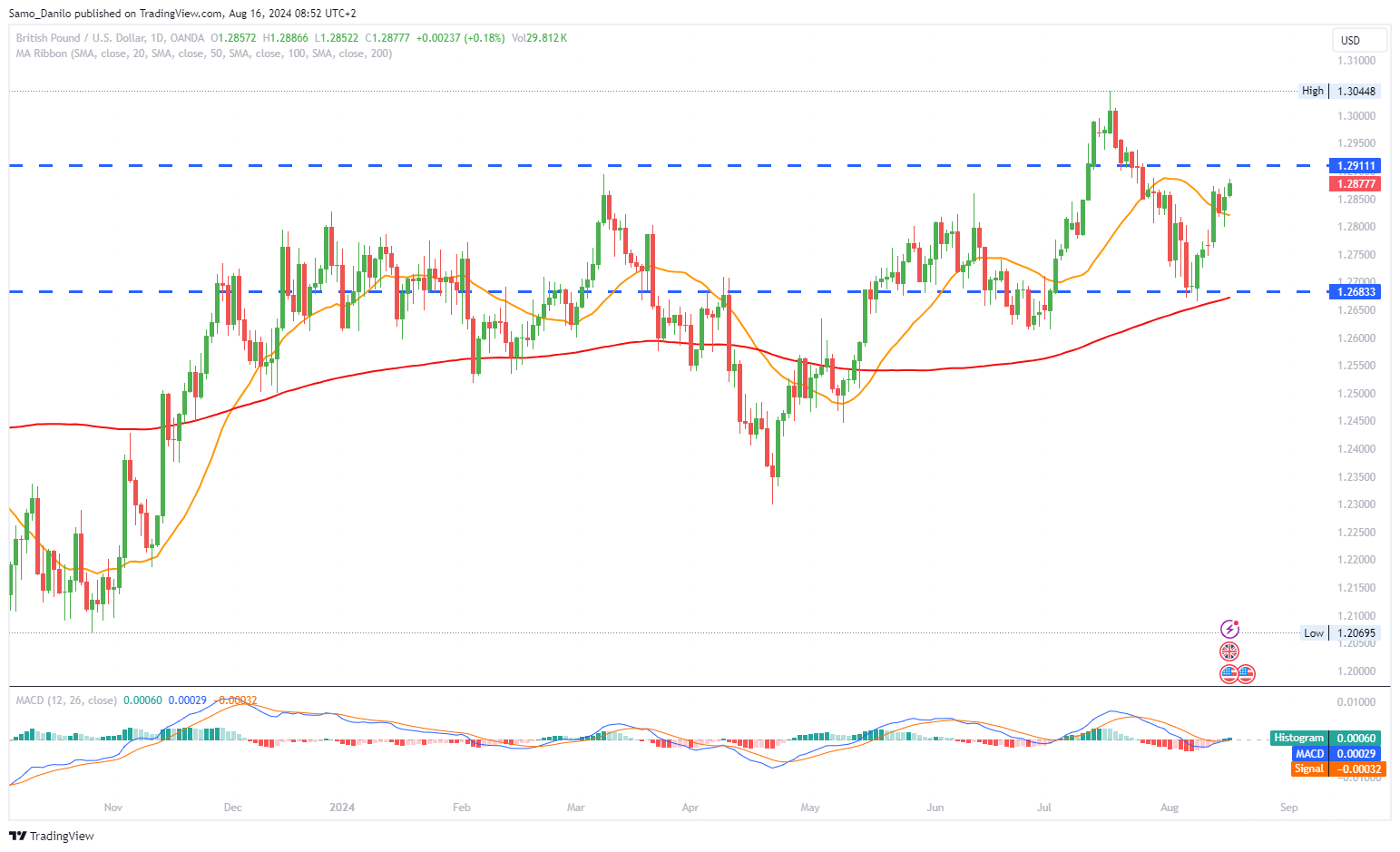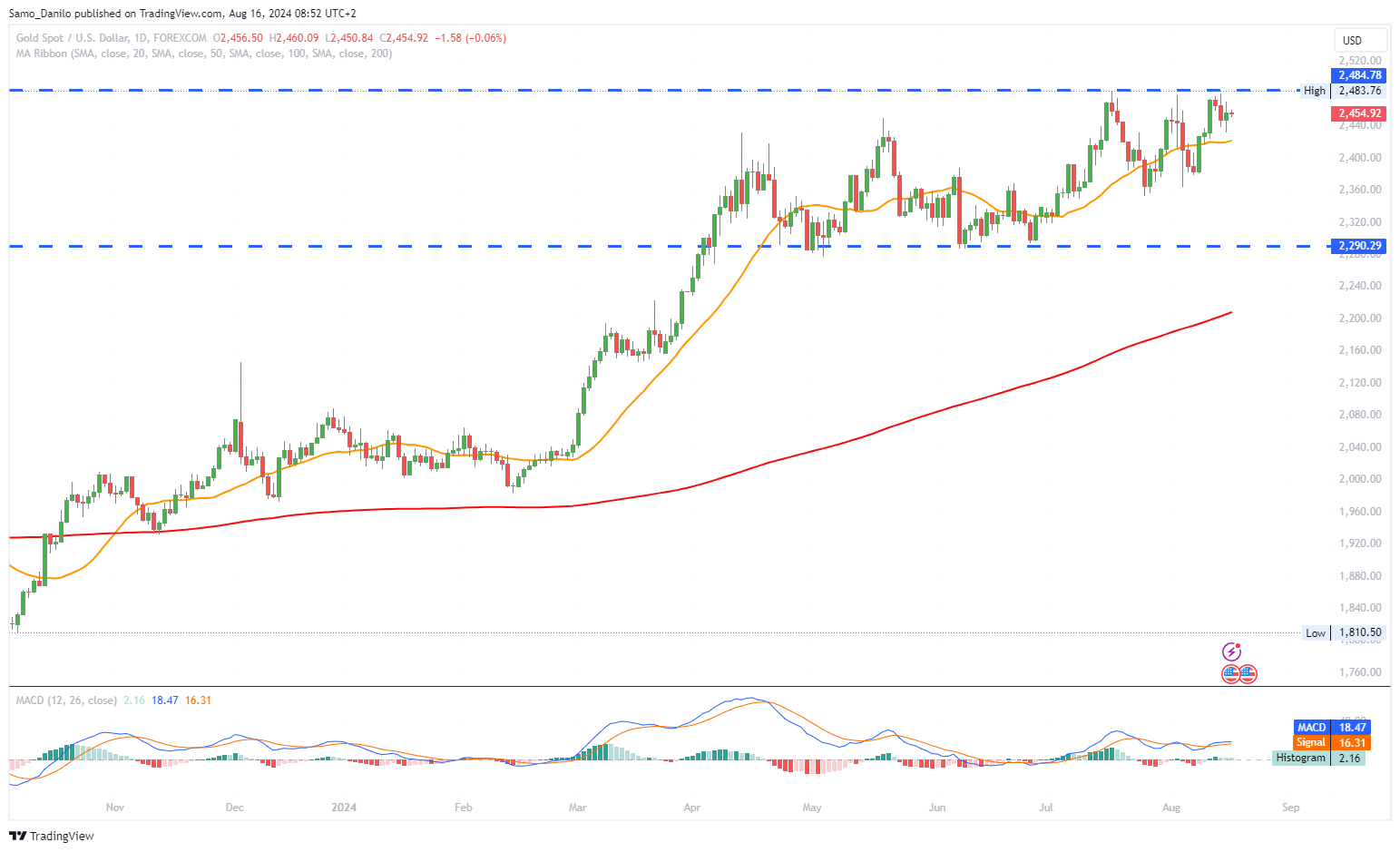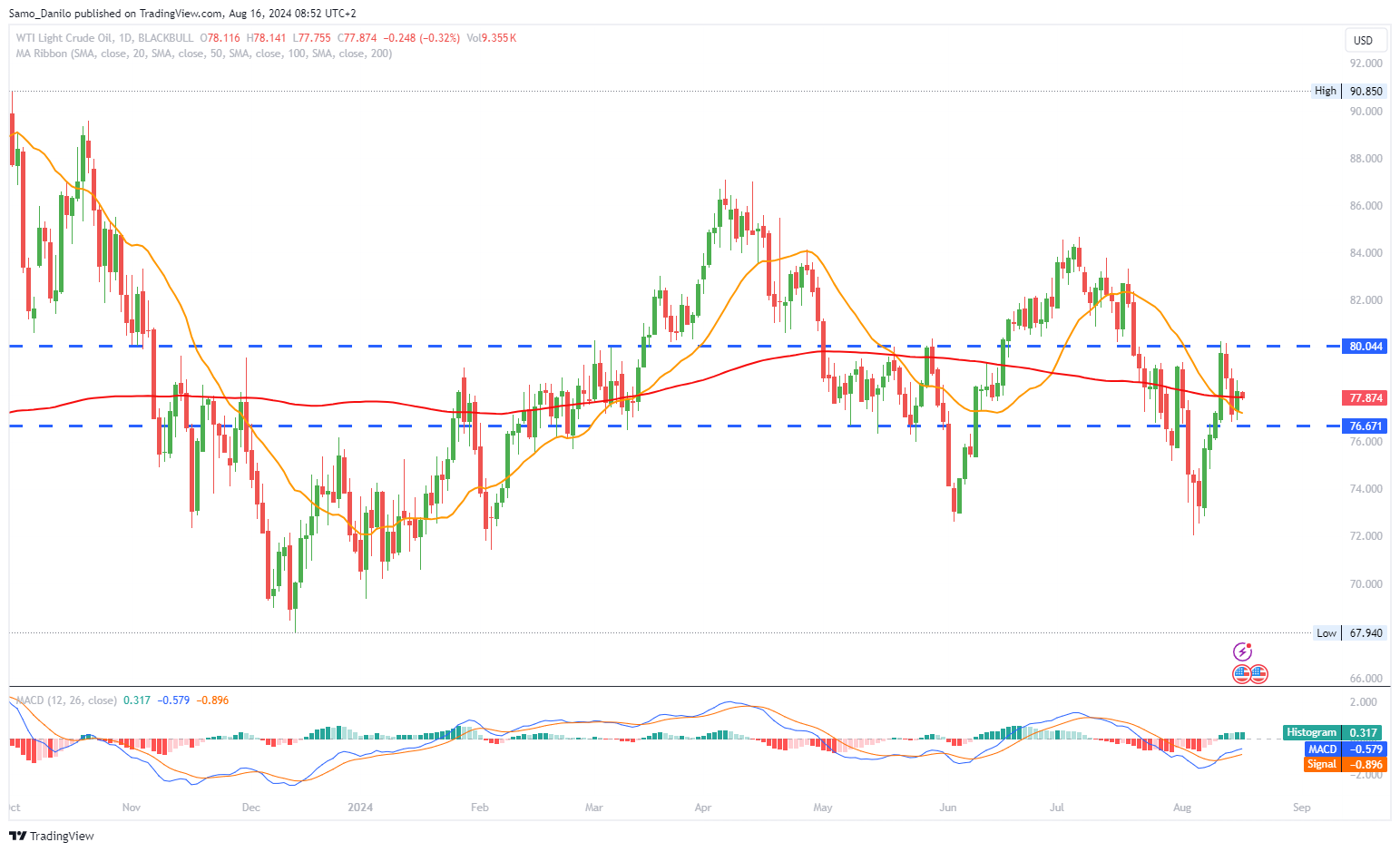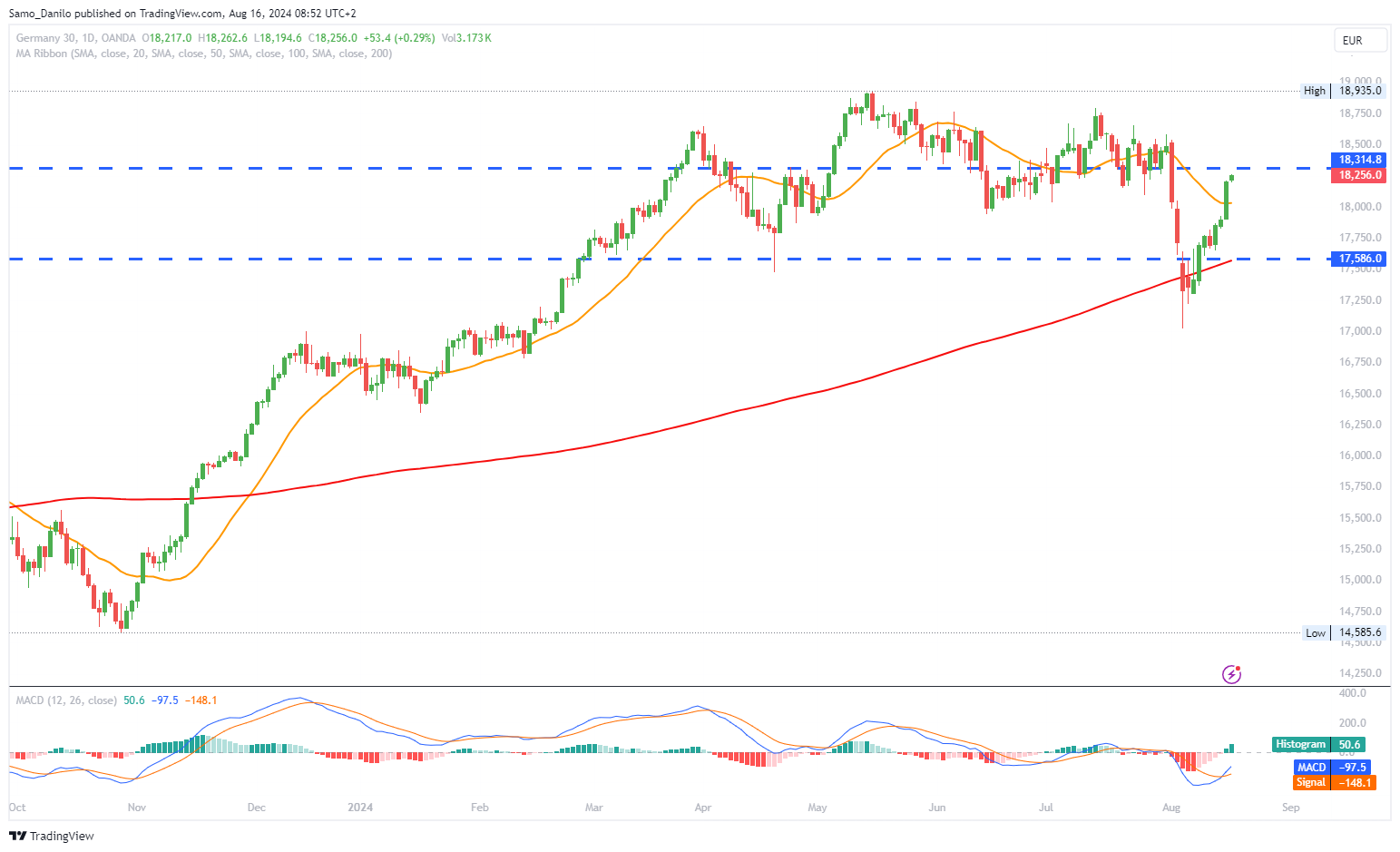EURUSD
- EUR/USD Performance: The EUR/USD pair extended its recovery during the European session on Friday, building on the late rebound from the 1.0950 area observed the previous day. This marks a continuation of positive momentum as the pair gains traction.
- US Economic Data Impact: On Thursday, the EUR/USD pair remained in a tight range during the first half of the session but experienced a decisive bearish movement following the release of July Retail Sales data. The data showed an unexpected increase of 1%, significantly surpassing the 0.3% gain anticipated by market participants.
- Additional data: Initial Jobless Claims for the week ending August 9 came in at 227K, better than the expected 235K. Despite this, later in the day, the US released fewer encouraging figures, with Capacity Utilization at 77.8% in July and Industrial Production down by 0.6% in the same month, missing expectations.
- Eurozone and US Data Releases: On Friday, market participants will focus on the release of the Eurozone's June Trade Balance, which could influence the EUR/USD pair's direction. Simultaneously, the US will release the preliminary estimate of the August Michigan Consumer Sentiment Index and the Michigan Consumer Inflation Expectations for the same month.
- Market Sentiment: The EUR/USD pair is currently navigating a mixed landscape of economic data from both sides of the Atlantic. While positive US retail sales data initially weighed on the Euro, the less-than-encouraging industrial production and capacity utilization figures have provided some support for the common currency.
Closing statement: The EUR/USD pair is in a state of flux, driven by mixed economic data from both the Eurozone and the US. With key data releases expected from both regions on Friday, the pair could experience further volatility. Market participants should pay close attention to the Eurozone's Trade Balance and the US Michigan Consumer Sentiment Index, which could set the tone for the EUR/USD's next move.
GBPUSD
- GBP/USD Performance: The GBP/USD pair is holding onto gains, trading higher and approaching the 1.2900 mark during the European morning on Friday. This reflects a steady upward movement as the pair continues to find support from recent economic data.
- UK Economic Data: The pair is digesting mixed UK Retail Sales data for July, which showed a monthly increase of 0.5%, in line with market expectations. This consistency in retail sales growth offers some stability to the British Pound.
- Additional data: Early on Thursday, the UK's Office for National Statistics reported that the UK’s Gross Domestic Product (GDP) expanded at an annual rate of 0.9% in the second quarter. This growth rate, though modest, aligns with expectations and supports the GBP/USD pair.
- US Economic Data: Across the Atlantic, the latest Initial Jobless Claims figures for the week ending August 9 came in at 227,000, lower than the forecasted 235,000 and a decrease from the previous week’s 234,000. This better-than-expected data has provided some support to the US Dollar, though it hasn’t significantly dented the GBP/USD's upward momentum.
- Upcoming Data to Watch: Later in the North American session, traders will be keenly watching the release of the preliminary US Michigan Consumer Sentiment Index for August and Building Permits data for July.
| SMA (20) | Slightly Falling |
| |
| RSI (14) | Slightly Rising |
| |
| MACD (12, 26, 9) | Rising |
|
|
Closing statement: The GBP/USD pair is maintaining its upward momentum, heading towards the 1.2900 mark, supported by stable UK economic data. As traders await further US data releases, particularly the Michigan Consumer Sentiment Index and Building Permits figures, the pair could see additional movement. Market participants should stay alert to these developments, as they may set the tone for GBP/USD's next move.
GOLD
- Gold Price Movement: Gold is holding onto recent recovery gains, maintaining a strong position above the $2,450 psychological level early on Friday. This resilience suggests sustained optimism among investors, supporting the precious metal’s value.
- US Retail Sales Data: The latest US Retail Sales data revealed a substantial increase of 1% month-over-month, significantly surpassing the anticipated 0.3% rise. The strong retail sales figures, adjusted for seasonality but not inflation, indicate robust consumer spending, which could influence the Federal Reserve's economic outlook.
- Initial Jobless Claims: In other positive news for the US economy, Initial Jobless Claims for the week ending August 10 decreased to 227,000, down from 234,000 the previous week and below the forecast of 235,000. This drop suggests a healthy labor market, which could impact the Fed’s policy decisions.
- Upcoming Data and Fed Commentary: Traders are eagerly awaiting the US Michigan Consumer Sentiment and Inflation Expectations data, set to be released later Friday. These indicators will provide additional insights into consumer confidence and inflation expectations, crucial for forecasting the Federal Reserve’s next moves.
- Fedspeak: A speech from Chicago Fed President Austan Goolsbee will be closely monitored for any fresh hints regarding the size and timing of the Fed’s next interest rate cut. His comments could have a significant impact on market sentiment and, by extension, gold prices.
| SMA (20) | Slightly Rising |
|
| RSI (14) | Slightly Rising |
|
| MACD (12, 26, 9) | Slightly Rising |
|
Closing statement: Gold prices are defending the $2,450 level, buoyed by strong US economic data and cautious optimism ahead of key data releases and Fed commentary. Investors will closely watch the upcoming Michigan Consumer Sentiment and Inflation Expectations data, along with remarks from Fed President Austan Goolsbee, for further clues on the direction of the US economy and the Fed’s policy, which could influence the future trajectory of XAU/USD.
CRUDE OIL
- Crude Oil Price Movement: West Texas Intermediate (WTI) crude oil prices are experiencing mild negative pressure during the European session on Friday, failing to fully capitalize on the previous day's bounce from the weekly low. This indicates ongoing market uncertainty.
- Supply Disruption Concerns: The risk of supply disruptions remains a significant factor, with tensions escalating in the Middle East. These geopolitical risks continue to keep supply fears elevated, which usually supports crude oil prices.
- US Dollar Influence: The US Dollar (USD), despite its recent strength following positive economic data, is struggling to maintain momentum amid increasing speculation that the Federal Reserve (Fed) might begin a rate-cutting cycle as early as September. The weakening USD often supports crude oil prices as it makes oil cheaper for holders of other currencies, but this influence is being offset by other factors.
- Demand Growth Downgrade: Both OPEC (Organization of the Petroleum Exporting Countries) and the IEA (International Energy Agency) have downgraded their forecasts for oil demand growth in 2024. This bearish outlook on future demand growth is adding downward pressure on crude oil prices, as it suggests weaker global economic activity.
- US Inventory Build: Additionally, an unexpected build in US crude oil inventories has been reported, indicating that demand may be cooling. This surprise increase in stockpiles is a bearish signal for crude oil prices, contributing to the mild negative bias seen in the market.
| SMA (20) | Falling |
|
|
| RSI (14) | Slightly Rising |
| |
| MACD (12, 26, 9) | Rising |
|
|
Closing statement: Crude oil prices are struggling to maintain upward momentum, with a mix of elevated supply disruption risks due to Middle East tensions and a weakening US Dollar failing to fully offset bearish factors. These include downgraded oil demand growth forecasts from OPEC and the IEA, as well as an unexpected build in US inventories, which suggests cooling demand. As the week ends, these factors are exerting downward pressure on WTI prices, reflecting a complex and uncertain market environment.
DAX
- DAX Market Movers: Positive US economic indicators have fueled demand for DAX- listed stocks, particularly in the auto, banking, and tech sectors. This reflects investor optimism driven by encouraging data from the United States, which is bolstering confidence in these key industries.
- Technical Indicators: From a technical standpoint, the DAX is showing bullish signals as it sits above both the 50-day and 200-day Exponential Moving Averages (EMAs). This positioning is often seen as a positive indicator, suggesting that the DAX is in an upward trend and attracting buyers.
- US Economic Sentiment: Positive sentiment toward the US economy is contributing to the DAX's strength. Recent US economic indicators have eased fears of a potential hard landing for the US economy. The market now expects multiple interest rate cuts from the Federal Reserve in 2024, which is further driving demand for DAX stocks.
- US Retail Sales: US retail sales figures surged by 1.0% month-on-month in July, rebounding from a 0.2% decline in June. These better-than-expected sales numbers have played a crucial role in calming investor concerns about the US economy, which, in turn, supports the DAX as global economic interdependencies remain strong.
- Eurozone Trade Data: Looking ahead, Eurozone trade data set to be released on Friday will be a key focus for investors. Economists predict that the trade surplus will narrow slightly, from €13.9 billion in May to €13.3 billion in June. This data could influence market sentiment, particularly regarding the broader health of the Eurozone economy.
| SMA (20) | Slightly Falling |
| |
| RSI (14) | Rising |
|
|
| MACD (12, 26, 9) | Rising |
|
|
The DAX is benefiting from a combination of positive US economic indicators and technical bullish signals, which are driving demand for stocks in key sectors such as autos, banking, and technology. As fears of a hard US economic landing subside and expectations of Fed rate cuts grow, the DAX continues to gain strength. However, upcoming Eurozone trade data could influence investor sentiment as they assess the region's economic performance. Overall, the DAX remains on a positive trajectory, supported by both domestic and international factors.
